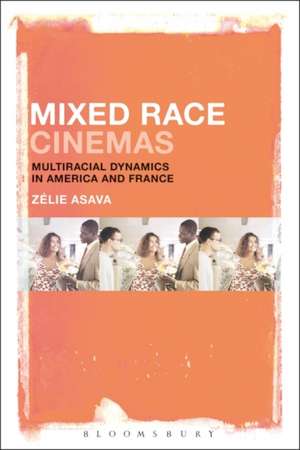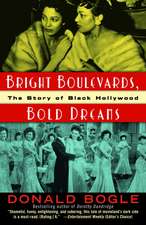Mixed Race Cinemas: Multiracial Dynamics in America and France
Autor Dr. Zélie Asavaen Limba Engleză Paperback – 20 mar 2019
| Toate formatele și edițiile | Preț | Express |
|---|---|---|
| Paperback (1) | 229.68 lei 43-57 zile | |
| Bloomsbury Publishing – 20 mar 2019 | 229.68 lei 43-57 zile | |
| Hardback (1) | 714.19 lei 43-57 zile | |
| Bloomsbury Publishing – 6 sep 2017 | 714.19 lei 43-57 zile |
Preț: 229.68 lei
Preț vechi: 296.50 lei
-23% Nou
Puncte Express: 345
Preț estimativ în valută:
43.96€ • 47.77$ • 36.95£
43.96€ • 47.77$ • 36.95£
Carte tipărită la comandă
Livrare economică 21 aprilie-05 mai
Preluare comenzi: 021 569.72.76
Specificații
ISBN-13: 9781501351389
ISBN-10: 1501351389
Pagini: 216
Ilustrații: 10 bw illus
Dimensiuni: 152 x 229 x 12 mm
Greutate: 0.29 kg
Editura: Bloomsbury Publishing
Colecția Bloomsbury Academic
Locul publicării:New York, United States
ISBN-10: 1501351389
Pagini: 216
Ilustrații: 10 bw illus
Dimensiuni: 152 x 229 x 12 mm
Greutate: 0.29 kg
Editura: Bloomsbury Publishing
Colecția Bloomsbury Academic
Locul publicării:New York, United States
Caracteristici
Considers
work
from
the
two
biggest
film
industries
in
the
West,
America
and
France,
societies
with
large
mixed-race
populations
whose
screen
cultures
have
a
global
impact
both
artistically
and
ideologically
Notă biografică
Zélie
Asavais
an
Assistant
Film
Classifier
at
the
Irish
Film
Classification
Office
and
lectures
on
Film
Studies
at
University
College
Dublin.
Her
monographThe
Black
Irish
Onscreen:
Representing
Black
and
Mixed-Race
Identities
on
Irish
Film
and
Television(2013)
examines
racial
representations
in
Irish
screen
culture
from
the
1990s
to
the
present
day.
She
is
the
co-author
of
'Race
and
Cinema'
inOxford
Bibliographies
Online:
Cinema
and
Media
Studies(2013),
and
has
published
many
essays
on
race,
gender
and
sexuality
in
American,
Irish,
French
and
Francophone
African
cinemas
in
a
wide
range
of
journals
and
edited
collections,
including:Masculinity
and
Irish
Popular
Culture:
Tiger's
Tales(2014);World
Cinema
Directory:
Africa(2014);Viewpoints:
Theoretical
Perspectives
on
Irish
Visual
Texts(2013);
Images
of
the
Modern
Vampire:
The
Hip
and
the
Atavistic(2013);France's
Colonial
Legacies:
Memory,
Identity
and
Narrative(2013);World
Cinema
Directory:
France(2013);Contemporary
Irish
Film:
New
Perspectives
on
a
National
Cinema(2011).
Cuprins
Introduction1.
Race
and
Ideology2.
Mixed-Race
Cinema
Histories3.
Interrogating
Terminology4.
Methodology
and
Frameworks5.
Mixed-Race
Spaces
in
French
and
American
Cinema6.
Franco-American
Narratives
and
Beur
Cinema7.
Summary
of
ChaptersChapter
One:
the
Mixed
Question1.
Language,
Representation
and
Casting2.
The
Historical
Mulatta
Screen
Stereotype
in
America3.
The
Historical
Mulatta
Screen
Stereotype
in
FranceChapter
Two:
Hollywood's
'Passing'
Narratives1.
'Passing'
Representations
as
Ideological
Construct
2.
The
Dichotomies
of
Post-War
Mixed-Race
Women
Onscreen
3.
Gender,
'Passing'
and
LoveChapter
Three:
The
Limits
of
the
Classic
Hollywood
'Tragic
Mulatta'1.
Imitation
of
Life
(1934):
Interrogating
Mixed
Identities2.
Casting
and
Representation
3.
Shadows
and
the
Interracial
Family4.
Imitation
of
Life,
1959:
Gender,
Difference
and
Voiced
Rebellion5.
Performative
Identities:
Sara
Jane,
Dandridge
and
MonroeChapter
Four:
Cultural
Shifts:
New
Waves
in
Racial
Representation1.
Representing
'Mixed-Race
France'2.
Reimagining
the
Nation:
Mixed
Families3.
Questioning
Mixed
Masculinity:
Les
Trois
frères4.
Melodrama,
Motherhood
and
Masks:
Métisse5.
Racial-Sexual
Mythology
and
the
Interracial
FamilyChapter
Five:
Transnational
Families
in
Drôle
de
Félix1.
A
Search
for
Identity
on
the
Road2.
Citizenship,
Violence
and
Scopophilia3.
Trauma
and
Redemption4.
Destabilising
the
Primary
Authority
of
the
Father5.
Reuniting
Transnational
FamiliesConclusion1.
'Post-Race'
Politics
in
America
and
France2.
Enduring
Stereotypes3.
Mixed-Race
Sci-Fi4.
Mixed
Representational
PotentialsBibliographyIndex
Recenzii
Zélie
Asava'sMixed
Race
Cinemas:
Multiracal
Dynamics
in
America
and
Franceis
an
important
contribution
to
mixed
race
studies,
because
representation
is
treated
as
the
source
of
identity,
rather
than
its
effect.
Asava
focuses
on
female
black-white
mixed
race
in
film,
from
the
tragic
mulatta
figure,
through
passing,
over
the
20th
c,
and
shows
how
these
earlier
tropes
continue
into
our
own
"post-binary"
times.
Fascinating,
seductive,
suffering,
passive,
and
triumphant,
these
racially
ambiguous
actors
and
their
characters
timelessly
reflect
and
create
broad
human
conditions
of
provincialism,
cosmopolitanism,
oppression,
liberation,
grief,
and
joy.Mixed
Race
Cinemasshould
be
required
reading
for
all
students
of
race
and
gender,
as
well
as
those
who
appreciate
film.
Zélie Asava makes an important contribution with this smartly researched study of mixed race representation in U.S. and French films. Her analysis of relevant films and the mixed racial politics of these two national cinemas is cogent and sharply illuminating.
Zélie Asava is a bold new voice in cinematic and mixed-race studies. She follows up her path-breaking first book,The Black Irish Onscreen, withMixed Race Cinemas, a trenchant examination of mixed-race figures in nearly a century of French and American film, from the movies of Oscar Micheaux to mixed-race scifi. Her writing is grounded in but not burdened by theory and offers a fine-grained gender analysis. In offering sometimes startling insights, she deepens our understandings of the different racial systems that have evolved in each of these countries. This is a terrific book.
Zélie Asava makes an important contribution with this smartly researched study of mixed race representation in U.S. and French films. Her analysis of relevant films and the mixed racial politics of these two national cinemas is cogent and sharply illuminating.
Zélie Asava is a bold new voice in cinematic and mixed-race studies. She follows up her path-breaking first book,The Black Irish Onscreen, withMixed Race Cinemas, a trenchant examination of mixed-race figures in nearly a century of French and American film, from the movies of Oscar Micheaux to mixed-race scifi. Her writing is grounded in but not burdened by theory and offers a fine-grained gender analysis. In offering sometimes startling insights, she deepens our understandings of the different racial systems that have evolved in each of these countries. This is a terrific book.
















